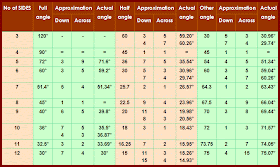
The past few days have been spent developing a modular hexagonal box which bounces and a related modular hexagonal box which stacks but does not bounce.
The two box types can be combined, in various combinations, to form a tier box which bounces. The combination model can even be connected near the base to form strings of boxes or hexagonal "circles" of tiered boxes.
The photo shows one way of connecting the sections. It is a photo of the rough proto-type models so don't look for perfection. Expect to see crumple, because it is certainly there! Designing a model generally results in a lot of messy models before the final version is reached. Unless you are Robert Lang, of course.
There are six sheets of paper used for each of the several sections.
Almost all of the starting sheets are half squares, that is, rectangles with a 2:1 ratio. The patterns can be printed onto paper via an ordinary computer printer. The limitation here is that the largest piece can be no taller than the length between the minimum printer margins at the top and bottom of a page. This translates to a box with a diameter of about 4½ inches.
The sections stack inside or around each other. Lids become bases to accommodate stems. Stems end in boxes which accommodate other boxes and/or lids.
There are two lid styles. One is an overlay style, the other fits flush with a base box but overlays an inlay box. One of the two lid styles is being used as the base for an extension tier in the photographed example while the other is on top of the model.
The box wobbles from the base. The wobble part is obscured in the photograph which was taken from the top to show the lid decoration.
It will be several days before all the problems of its construction are resolved at which point I will make it with a variety of colored papers which will better demonstrate the modular and the sectional construction. Then I will post the Crease Patterns for each model of each section.
There are several sections which are not shown in the photo. One inlay box style is still in design infancy. Two other inlay styles were stackers which were not photographed because there insufficient lids to accommodate them. Photos of these will be posted in blog postings to come.
This is a fun box which, nevertheless, has practical applications.
















